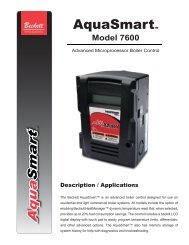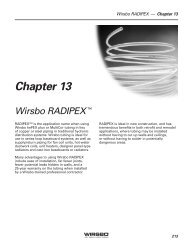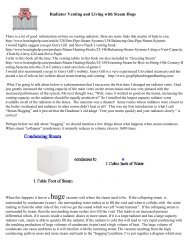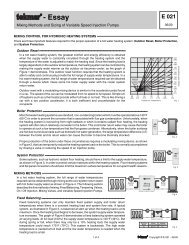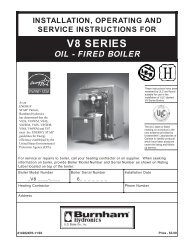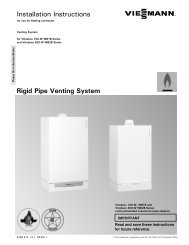Steam Locomotive Firebox Explosion on the Gettysburg Railroad ...
Steam Locomotive Firebox Explosion on the Gettysburg Railroad ...
Steam Locomotive Firebox Explosion on the Gettysburg Railroad ...
You also want an ePaper? Increase the reach of your titles
YUMPU automatically turns print PDFs into web optimized ePapers that Google loves.
Although it was not possible to determine<br />
<strong>the</strong> preaccident c<strong>on</strong>spicuity of <strong>the</strong> water<br />
glass, both firemen testified that <strong>the</strong>y had no<br />
trouble seeing <strong>the</strong> water glass. The cab of<br />
<strong>the</strong> locomotive was an all-wea<strong>the</strong>r enclosed<br />
<strong>on</strong>e of <strong>the</strong> type comm<strong>on</strong>ly found <strong>on</strong> steam<br />
locomotives used in nor<strong>the</strong>rn climates. The<br />
cab had side doors and o<strong>the</strong>r features that<br />
limited <strong>the</strong> entrance of light and air. Given<br />
<strong>the</strong> leng<strong>the</strong>ning shadows and <strong>the</strong> light of<br />
early evening, it is possible <strong>the</strong> amount of<br />
light in <strong>the</strong> cab and <strong>on</strong> <strong>the</strong> water glass was<br />
restricted.<br />
While <strong>the</strong> Safety Board does not dispute<br />
<strong>the</strong> claims of <strong>the</strong> firemen that <strong>the</strong>y had no<br />
problem reading <strong>the</strong> water glass, <strong>the</strong> Board<br />
believes that a working light <strong>on</strong> <strong>the</strong> water<br />
glass, as required by <strong>the</strong> regulati<strong>on</strong>s, would<br />
have made reading <strong>the</strong> water glass easier and<br />
might have yielded more accurate informati<strong>on</strong><br />
about <strong>the</strong> acti<strong>on</strong> of <strong>the</strong> water level in<br />
<strong>the</strong> water glass and, thus, <strong>the</strong> amount of<br />
water in <strong>the</strong> boiler. A working light might<br />
also have allowed <strong>the</strong> engineer, who indicated<br />
that <strong>the</strong> water-level movement was<br />
normally 4 to 5 inches, to see that <strong>the</strong> level<br />
was moving <strong>on</strong>ly an inch or less before <strong>the</strong><br />
accident. He might have realized that something<br />
was wr<strong>on</strong>g and been able to take<br />
preventive acti<strong>on</strong>.<br />
Water Treatment--Since scale, particularly<br />
as it affected <strong>the</strong> water-m<strong>on</strong>itoring devices,<br />
became a factor in <strong>the</strong> investigati<strong>on</strong>, Safety<br />
Board investigators explored how <strong>Gettysburg</strong><br />
Passenger Services treated its water in<br />
order to c<strong>on</strong>trol <strong>the</strong> mineral c<strong>on</strong>tent.<br />
According to experienced steam-locomotive<br />
operators and historical railroad documentati<strong>on</strong>,<br />
water treatment is critical to <strong>the</strong><br />
maintenance and safe operati<strong>on</strong> of steam<br />
locomotives. Testim<strong>on</strong>y from steam-locomotive<br />
experts and investigators, from <strong>the</strong><br />
owner of <strong>Gettysburg</strong> <strong>Railroad</strong>, and from<br />
representatives of <strong>Gettysburg</strong> Passenger<br />
Services showed that water treatment for<br />
locomotive 1278 was, at best, undocumented<br />
and inc<strong>on</strong>sistent.<br />
The attempts at water treatment appeared<br />
to be irregular, ra<strong>the</strong>r than part of a planned<br />
and researched policy. According to his<br />
testim<strong>on</strong>y, <strong>the</strong> engineer sent boiler- and/or<br />
supply-water samples to Water Chem for<br />
testing. However, Water Chem has no<br />
record of doing any testing for <strong>Gettysburg</strong><br />
Passenger Services. The engineer told Safety<br />
Board investigators that he did his own<br />
water testing with a kit and that he kept a<br />
journal of his testing. There was no<br />
documented evidence that this was d<strong>on</strong>e <strong>on</strong><br />
a regular, program-type basis or that<br />
anything was d<strong>on</strong>e with any test result<br />
informati<strong>on</strong>. Investigators were unable to<br />
determine <strong>the</strong> effectiveness of such irregular<br />
water treatment, since no test results were<br />
found or provided. The Safety Board<br />
c<strong>on</strong>cludes that <strong>Gettysburg</strong> Passenger Services<br />
did not have a comprehensive watertreatment<br />
program. The Safety Board<br />
believes that <strong>the</strong> FRA should require steamlocomotive<br />
operators to have a documented<br />
water-treatment program as a basis for boiler<br />
maintenance and operati<strong>on</strong>.<br />
Boiler Washing--The first fireman’s testim<strong>on</strong>y<br />
about boiler washing described <strong>the</strong><br />
manner in which <strong>Gettysburg</strong> Passenger<br />
Services pers<strong>on</strong>nel washed <strong>the</strong> boiler.<br />
C<strong>on</strong>trary to <strong>the</strong> regulatory requirement that<br />
all washout plugs be removed, <strong>the</strong> fireman<br />
removed <strong>on</strong>ly 4 of <strong>the</strong> boiler’s 29 washout<br />
plugs. With <strong>on</strong>ly four plugs removed, it is<br />
doubtful that even <strong>the</strong> most c<strong>on</strong>scientious<br />
effort to wash out <strong>the</strong> boiler would have<br />
been very effective in removing a significant<br />
amount of sediment.<br />
42



